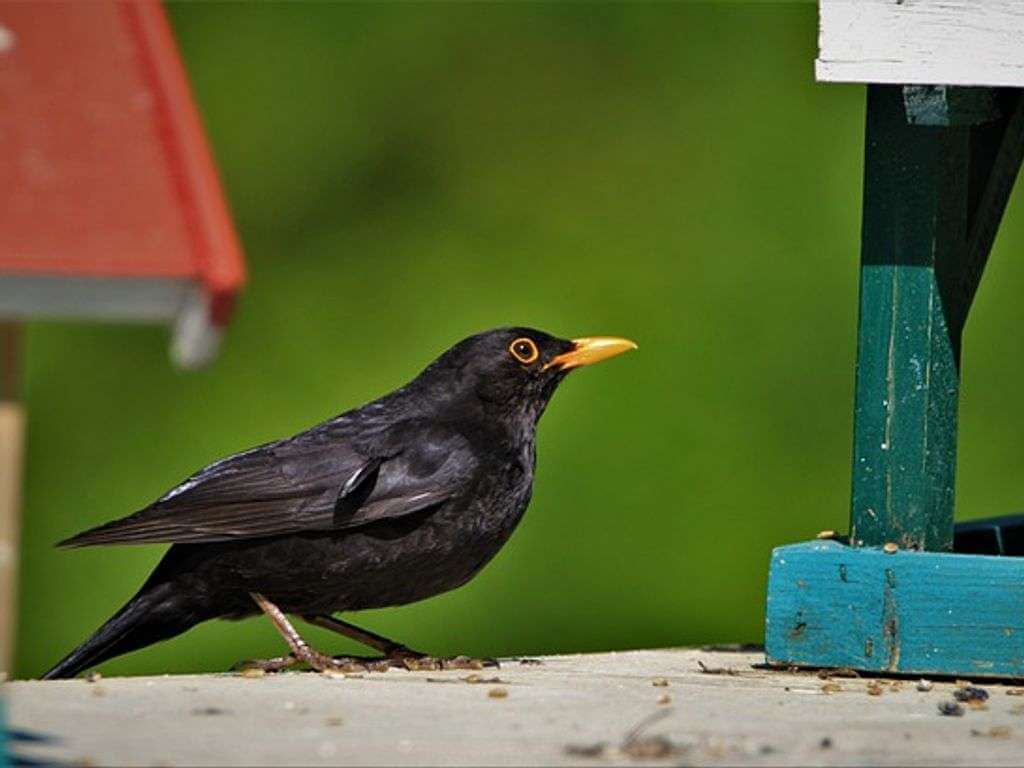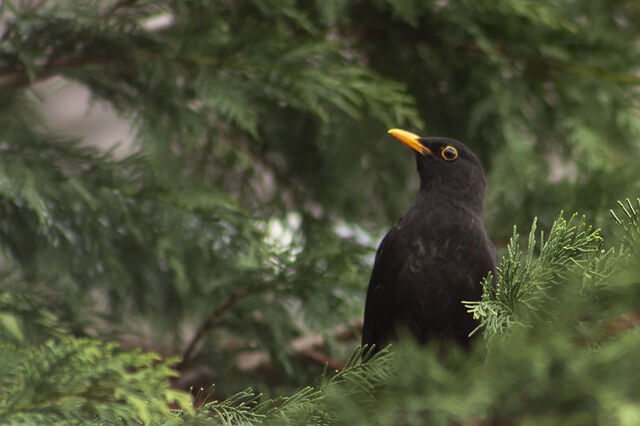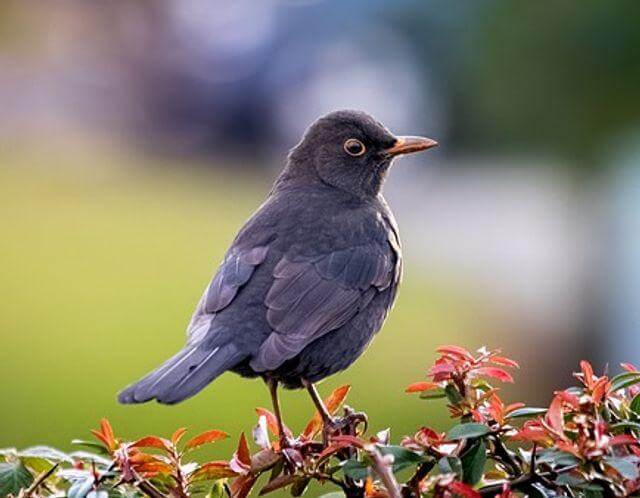Are you ready to explore the world of fascinating black birds with vibrant yellow beaks? In this guide, we’ll introduce you to 11 captivating species that boast unique and striking features.
These birds are not only a treat for the eyes but also offer intriguing insights into the avian world. Let’s dive into the captivating world of these remarkable creatures!
Table of Contents
- 1 Types of Black Birds With Yellow Beaks
- 2 Frequently Asked Questions
- 2.1 Is there a crow with a yellow beak?
- 2.2 Do grackles have yellow beaks?
- 2.3 Does a raven have a yellow beak?
- 2.4 Why do some starlings have yellow beaks?
- 2.5 What are small blackbirds with yellow beaks called?
- 2.6 Do robins have yellow beaks?
- 2.7 What bird is black and white with a yellow beak?
- 2.8 Is there a big black bird with a yellow beak?
- 2.9 Are there black and white birds with yellow beaks?
- 2.10 Are there little black birds with yellow beaks?
- 2.11 Which birds are black with a yellow beak and orange feet?
- 2.12 Are there black and brown birds with yellow beaks?
- 2.13 Do crows have yellow beaks?
- 2.14 Can you spot a dark brown bird with a yellow beak?
- 2.15 Which birds are black and white with a large yellow beak?
- 2.16 Are there black speckled birds with yellow beaks?
- 2.17 Can you identify a shiny black bird with a yellow beak?
- 2.18 What blackbird species has a yellow beak?
- 2.19 Which black birds have yellow eyes and beaks?
- 3 Author
Types of Black Birds With Yellow Beaks
Yellow-billed Chough
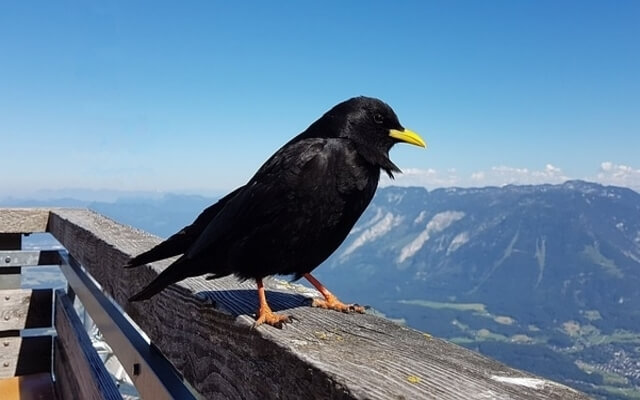
The captivating Yellow-Billed Chough (Pyrrhocorax graculus) enchants with its distinctive features, sporting sleek black plumage, a vivid yellow beak, and striking red legs.
This crow family member graces coastal grasslands, dry scrublands, and rocky cliffs across New Zealand, Australia, South Africa, and Southern Europe.
Clocking in at an average length of around 29.5-33.5 inches (75-85 cm) and weighing 10.6-12.3 ounces (300–350 grams), it dines omnivorously on insects, small mammals, fruits, and plant matter.
With a lifespan of 10–15 years, some populations embark on seasonal migrations, adding an air of wonder to its character. Despite its charm, its conservation status beckons concern due to habitat challenges.
| Characteristic | Info |
|---|---|
| Scientific Name | Pyrrhocorax graculus |
| Wingspan | 29.5-33.5 in (75-85 cm) |
| Average Weight | 10.6-12.3 oz (300-350 g) |
| Habitat | Coastal grasslands, cliffs |
| Diet | Insects, mammals, fruits |
| Lifespan | 10-15 years |
| Migratory | Partially migratory |
| Conservation Status | Concern |
Eurasian Blackbird

The Eurasian Blackbird (Turdus merula) captivates with its enchanting presence. Dressed in dark plumage, the male is a sight to behold, with its vibrant yellow beak adding a touch of elegance.
Found across Europe and Asia, it thrives in varied habitats including woodlands, gardens, and parks. Its diet spans insects, earthworms, fruits, and berries, showcasing its versatile palate.
With an average length of approximately 10.2-10.8 inches (26-27.5 cm) and a wingspan of around 14.6-16.1 inches (37-41 cm), it weighs about 80–125 grams. Endearing and melodious, its song graces the airwaves.
This adaptable species boasts a lifespan of 2–3 years and though not migratory, it may exhibit local movements. The conservation status of the Eurasian Blackbird remains of least concern, symbolizing its enduring presence.
| Characteristic | Info |
|---|---|
| Scientific Name | Turdus merula |
| Wingspan | 12.6-15 in (32-38 cm) |
| Average Weight | 2.5-4.6 oz (70-130 g) |
| Habitat | Woodlands, urban areas |
| Diet | Insects, earthworms, fruits |
| Lifespan | Up to 20 years |
| Migratory | Non-migratory |
| Conservation Status | Least Concern |
European Starling

The European Starling (Sturnus vulgaris) is a captivating avian adorned with sleek black plumage, known for its enchanting iridescence when caught in the right light. Its distinctive yellow beak adds a vibrant touch to its appearance.
With an average length of approximately 8.5-9.5 inches (22-24 cm) and a weight of about 2.1-3.4 ounces (60-97 grams), this starling graces a wide range of habitats, from urban environments to open woodlands.
Its adaptable diet spans insects, fruits, and even scavenged human food. Exhibiting a lifespan of 2–3 years, this agile flier showcases remarkable acrobatics in flight, often forming mesmerizing murmurations.
As an indigenous species in Europe, the European Starling has spread to other regions, though its conservation status remains stable.
| Characteristic | Info |
|---|---|
| Scientific Name | Sturnus vulgaris |
| Wingspan | 8.7-12.2 in (22-31 cm) |
| Average Weight | 2.1-3.6 oz (60-100 g) |
| Habitat | Urban, rural, farmland |
| Diet | Insects, fruits, seeds |
| Lifespan | 3-4 years |
| Migratory | Migratory |
| Conservation Status | Least Concern |
Common Myna
The Common Myna, recognized by its captivating yellow beak, is a remarkable avian species. With its sleek black plumage and distinctive yellow facial features, including the prominent beak, it leaves a lasting impression.
This bird finds its habitat in urban and suburban landscapes across Asia, showcasing its adaptability.
Spanning approximately 9.8-12.2 inches (25-31 cm) in length, and weighing around 3.5-4.2 ounces (100-120 grams), the Common Myna thrives on a diverse diet of insects, fruits, and human scraps.
Exhibiting intelligence and resourcefulness, it often associates with human activity. With an average lifespan of 5–6 years, these birds do not partake in migratory behavior.
Although considered a species of least concern, its charisma, particularly the striking yellow beak, captures attention and fosters appreciation.
| Characteristic | Info |
|---|---|
| Scientific Name | Acridotheres tristis |
| Wingspan | 9.8-11.8 in (25-30 cm) |
| Average Weight | 4.2-5.3 oz (120-150 g) |
| Habitat | Urban, grasslands, gardens |
| Diet | Insects, fruits, garbage |
| Lifespan | 4-8 years |
| Migratory | Non-migratory |
| Conservation Status | Invasive in some areas |
Black Thrush
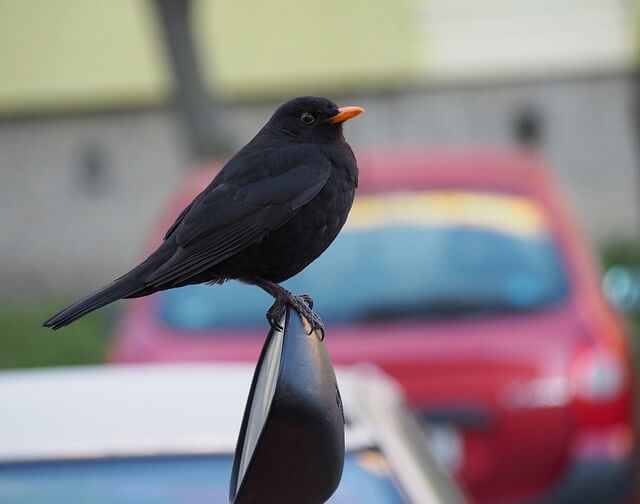
The elegant Black Thrush, with its enchanting ebony plumage, stands out vividly against nature’s canvas. Its yellow beak adds a vibrant touch to its appearance, creating a striking contrast.
This avian marvel finds its home amidst lush woodlands and verdant meadows, showcasing its splendid form across various habitats.
Spanning an average length of approximately 9–10 inches (23-25 cm), this bird boasts a melodious song that graces the air.
With a diet primarily composed of insects, fruits, and berries, the Black Thrush contributes to the ecosystem’s delicate balance.
Living up to 10–15 years, some populations undertake migratory journeys, underscoring their captivating nature.
As we admire the Black Thrush’s beauty, let us also remain mindful of its conservation status, safeguarding its habitat for generations to come.
| Characteristic | Info |
|---|---|
| Scientific Name | Turdus infuscatus |
| Wingspan | 10.2-11.8 in (26-30 cm) |
| Average Weight | 2.6-3.9 oz (75-110 g) |
| Habitat | Montane forests, shrublands |
| Diet | Insects, fruits, berries |
| Lifespan | Up to 8 years |
| Migratory | Non-migratory |
| Conservation Status | Near Threatened |
Yellow-legged Thrush
The resplendent Yellow-legged Thrush boasts an enchanting presence with its signature yellow beak.
Scientifically known as Turdus flavipes, this avian marvel showcases a captivating average wingspan of around 12 inches (30 cm) and a weight of approximately 3.5 ounces (100 grams).
Its preferred habitat encompasses lush forests and wooded areas across its native range in South America. Sporting a diverse palate, it feasts on insects, fruits, and berries, contributing to its vitality.
With a lifespan of 8–10 years, this splendid thrush exudes both a migratory and resident lifestyle, charming enthusiasts as it graces various regions.
It is important to note its conservation status, as habitat loss poses a potential threat to its radiant existence.
| Characteristic | Info |
|---|---|
| Scientific Name | Turdus flavipes |
| Wingspan | 9.8-10.6 in (25-27 cm) |
| Average Weight | 2.5-3.3 oz (70-95 g) |
| Habitat | Forests, gardens, plantations |
| Diet | Insects, fruits, berries |
| Lifespan | Up to 8 years |
| Migratory | Non-migratory |
| Conservation Status | Least Concern |
Common Hill Myna
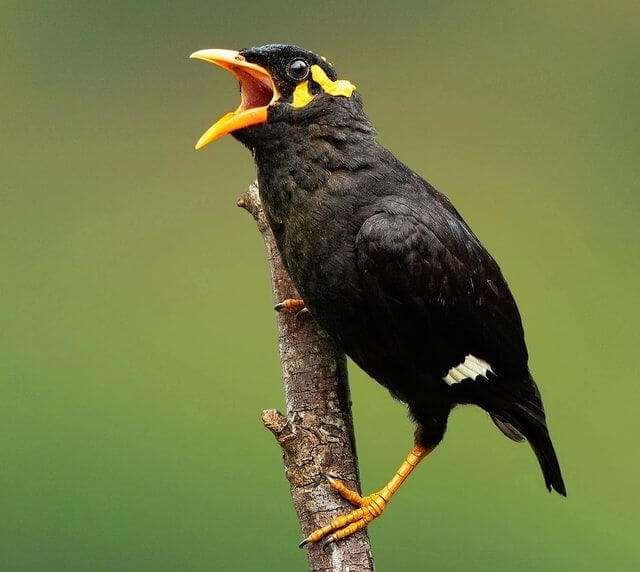
The captivating Common Hill Myna (Gracula religiosa) stands out with its unique traits, notably its ebony plumage and strikingly vibrant yellow beak.
Found in diverse habitats across South and Southeast Asia, this bird’s melodious calls and remarkable mimicry skills have earned it admiration.
With an average length of approximately 10-12 inches (25-30 cm) and a weight of about 100–140 grams, its captivating appearance is complemented by its omnivorous diet, which encompasses insects, fruits, and even human food scraps.
The Common Hill Myna’s companionship can be enjoyed for up to 20 years, as it showcases its non-migratory nature.
While its melodious calls often delight, its conservation status does warrant attention due to habitat loss and pet trade pressures, highlighting the need for protective measures.
| Characteristic | Info |
|---|---|
| Scientific Name | Gracula religiosa |
| Wingspan | 9.1-11 in (23-28 cm) |
| Average Weight | 5.3-6.7 oz (150-190 g) |
| Habitat | Forests, urban areas |
| Diet | Fruits, insects, nectar |
| Lifespan | 8-12 years |
| Migratory | Non-migratory |
| Conservation Status | Introduced, Invasive in some areas |
Steller’s Sea Eagle

The majestic Steller’s Sea Eagle (Haliaeetus pelagicus) commands attention with its grandeur. Adorned in striking monochrome plumage and crowned with a prominent yellow beak, this avian marvel dominates the coastal landscapes of northeastern Asia.
With an impressive wingspan averaging 6.6 to 8.2 feet (2 to 2.5 meters) and weighing in at around 15–20 pounds (6.8-9.1 kilograms), it reigns as one of the largest eagle species.
Its maritime domain shapes its diet, predominantly feasting on fish and waterfowl.
A symbol of endurance, it can live up to 30 years, while its migratory nature adds an element of wanderlust to its character.
Despite its awe-inspiring presence, the Steller’s Sea Eagle faces conservation challenges, highlighting the importance of safeguarding its habitat and well-being.
| Characteristic | Info |
|---|---|
| Scientific Name | Haliaeetus pelagicus |
| Wingspan | 78-96 in (200-245 cm) |
| Average Weight | 11-20 lb (5-9 kg) |
| Habitat | Coastal areas, large lakes, rivers |
| Diet | Fish, waterfowl, carrion |
| Lifespan | Up to 50 years |
| Migratory | Non-migratory |
| Conservation Status | Vulnerable |
Toucan
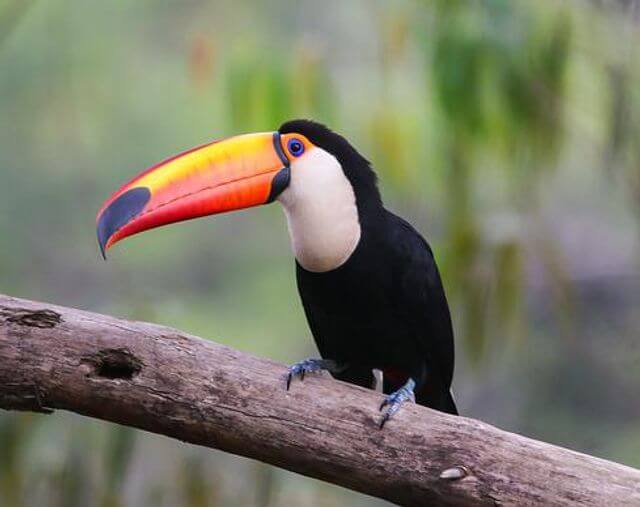
The Toucan, renowned for its vibrant and iconic yellow beak, is a true marvel of the avian world. With its striking plumage and that unmistakable feature, it captures the imagination of all who encounter it.
Scientifically referred to as Ramphastos, this tropical beauty graces the rainforests of Central and South America, adding a burst of color to lush habitats.
Measuring around 20–25 inches (50-65 cm) in length and weighing about 4–24 ounces (120-680 grams), this frugivorous marvel indulges in a diet primarily composed of fruits.
With an average lifespan of 15–20 years, these birds navigate their canopy homes with grace, reflecting their mastery of flight.
Despite their enduring appeal, some toucan species face habitat challenges that warrant conservation attention, ensuring their vibrant beaks continue to brighten the world.
| Characteristic | Info |
|---|---|
| Scientific Name | Ramphastos spp. |
| Wingspan | Varies |
| Average Weight | Varies |
| Habitat | Tropical rainforests |
| Diet | Fruits, insects, small prey |
| Lifespan | Up to 20 years |
| Migratory | Non-migratory |
| Conservation Status | Conservation concern, varies by species |
Indian Blackbird
The enchanting Indian Blackbird, renowned for its ebony plumage and striking yellow beak, is a captivating sight.
Scientifically known as Turdus simillimus, this avian marvel graces the landscapes of the Indian subcontinent.
With an average length of approximately 9–10 inches (23-25 cm), it boasts a melodious song that echoes through varied habitats, including forests, gardens, and urban areas.
Its diet encompasses a range of insects, fruits, and small invertebrates.
With an average lifespan of 10–15 years, the Indian Blackbird enchants both sight and sound, casting a spell with its vibrant appearance and melodic tunes.
| Characteristic | Info |
|---|---|
| Scientific Name | Turdus simillimus |
| Wingspan | 9.8-10.6 in (25-27 cm) |
| Average Weight | 2.5-3.3 oz (70-95 g) |
| Habitat | Grasslands, agricultural fields |
| Diet | Insects, fruits, berries |
| Lifespan | Up to 14 years |
| Migratory | Non-migratory |
| Conservation Status | Least Concern |
Double-crested Cormorant
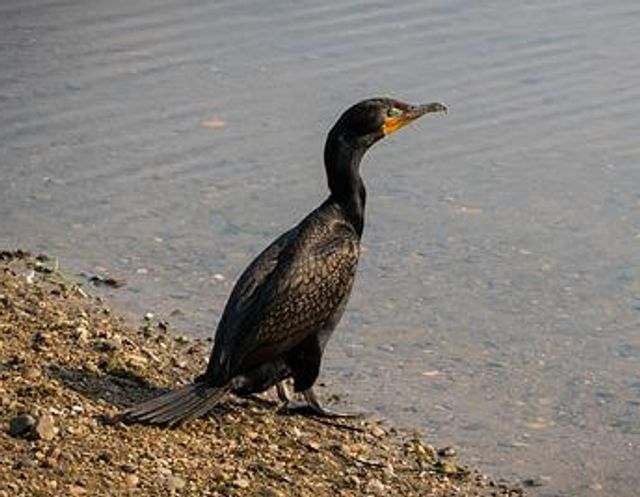
The Double-Crested Cormorant, distinguishable by its striking appearance and, notably, its yellow beak, is a remarkable avian species.
With an imposing wingspan and a body length averaging around 33-40 inches (84-102 cm), this aquatic marvel frequents coastal waters, lakes, and rivers across North America.
Sporting dark plumage and an unmistakable hooked bill, its diet predominantly consists of fish, showcasing its exceptional diving and swimming abilities.
With an average lifespan of 6–10 years, these cormorants exhibit both migratory and resident populations, traversing vast distances in pursuit of optimal habitats.
While their numbers have rebounded, they still encounter conservation considerations due to historical population declines and interactions with human activities.
| Characteristic | Info |
|---|---|
| Scientific Name | Phalacrocorax auritus |
| Wingspan | 35-45 in (89-114 cm) |
| Average Weight | 2.6-5.5 lb (1.2-2.5 kg) |
| Habitat | Coastal waters, lakes, rivers |
| Diet | Carnivorous: fish |
| Lifespan | 6-10 years |
| Migratory | Migratory |
| Conservation Status | Least Concern |
Frequently Asked Questions
Is there a crow with a yellow beak?
The Yellow-billed chough or Alpine Chough, is a species of bird in the crow family. It is found in much of Europe, Northern Africa and Asia, though its natural habitats are mountainous areas and temperate steppes. It is regarded by the IUCN as of least concern.
Do grackles have yellow beaks?
Grackles are not known for having yellow beaks. Typically, these birds have black beaks. They are often seen foraging for food and displaying their iridescent plumage.
Does a raven have a yellow beak?
Ravens do not have yellow beaks. They are more commonly recognized by their black or dark gray beaks, which complement their glossy black feathers. These intelligent birds are known for their distinctive calls and behaviors.
Why do some starlings have yellow beaks?
Some Starlings have yellow beaks during the different seasons because their bill changes color through the year. The black beak in the winter turns to a bright yellow come spring and summer, and then gradually turns back to black in the winter.
What are small blackbirds with yellow beaks called?
European Starling otherwise known as the Common Starling is a species of bird that can be found all over the world. They are small, blackbirds with yellow beaks. They are very common and can be found on almost any continent.
Do robins have yellow beaks?
American Robins don’t possess yellow beaks; their beaks are typically dark gray to black in color, which distinguishes them from birds with yellow beaks.
What bird is black and white with a yellow beak?
The Yellow-billed magpie is a bird species found only in California. This bird is black and white with a yellow beak. The yellow-billed magpie is found in the eastern portion of the state, from the Sacramento Valley to the east slope of the Sierra Nevada. This bird is usually seen near human dwellings, where it feeds on insects and other small creatures.
Is there a big black bird with a yellow beak?
Yes, there is a big black bird with a yellow beak. The Eurasian Golden Oriole is a large black bird with a bright yellow beak. It is known for its striking plumage and can be found in wooded areas across Europe.
Are there black and white birds with yellow beaks?
Indeed, the Eurasian Oystercatcher (Haematopus ostralegus) is a black and white bird known for its distinctive long, bright orange beak.
Are there little black birds with yellow beaks?
Yes, there are little black birds with yellow beaks. Examples include the Common Myna, European Starling, Common Blackbird, Red-winged Blackbird, and some species of thrush. The Yellow-billed Chough is also a black bird with a yellow beak.
Which birds are black with a yellow beak and orange feet?
You can find the Black Skimmer (Rynchops niger) fitting this description. They are distinctive for their black plumage, yellow-black beak, and bright orange legs.
Are there black and brown birds with yellow beaks?
Certainly, the Black-browed Albatross (Thalassarche melanophris) is an example of a bird with black and brown plumage and a yellow beak. These large seabirds are found in the Southern Ocean.
Do crows have yellow beaks?
No, most crows, like the American Crow, have black or gray beaks. Their plumage is entirely black, and they are recognized for their intelligence and adaptability.
Can you spot a dark brown bird with a yellow beak?
American Goldfinches (Spinus tristis) are often dark brown in the winter and display a yellow beak. They are known for their vibrant yellow plumage in the summer. These small songbirds are native to North America and are commonly found in gardens and open areas.
Which birds are black and white with a large yellow beak?
There are several bird species that are black and white with a large yellow beak. One example is the Yellow-billed Magpie (Pica nuttalli), which has a black body, white belly, and a distinctively large yellow bill. This bird is native to California and is known for its vibrant coloration and boisterous behavior.
Are there black speckled birds with yellow beaks?
Yes, the Cape Petrel (Daption capense) is an example of black speckled birds with distinctive yellow beaks. These seabirds are often seen in the Southern Ocean.
Can you identify a shiny black bird with a yellow beak?
The shiny black bird with a yellow beak is the European Starling (Sturnus vulgaris). European Starlings have a glossy black appearance and are commonly found in large flocks. They have a short, square tail and a slender, yellow beak. This bird species is native to Europe and was introduced to other countries, including North America.
What blackbird species has a yellow beak?
The Eurasian Blackbird (Turdus merula) is an example of a blackbird species with a bright yellow beak. They are widely distributed across Europe and Asia.
Which black birds have yellow eyes and beaks?
The Great Black-backed Gull (Larus marinus) is one of the black birds with yellow beaks and yellow eyes. These gulls are the largest in the world and are commonly seen in coastal areas.

